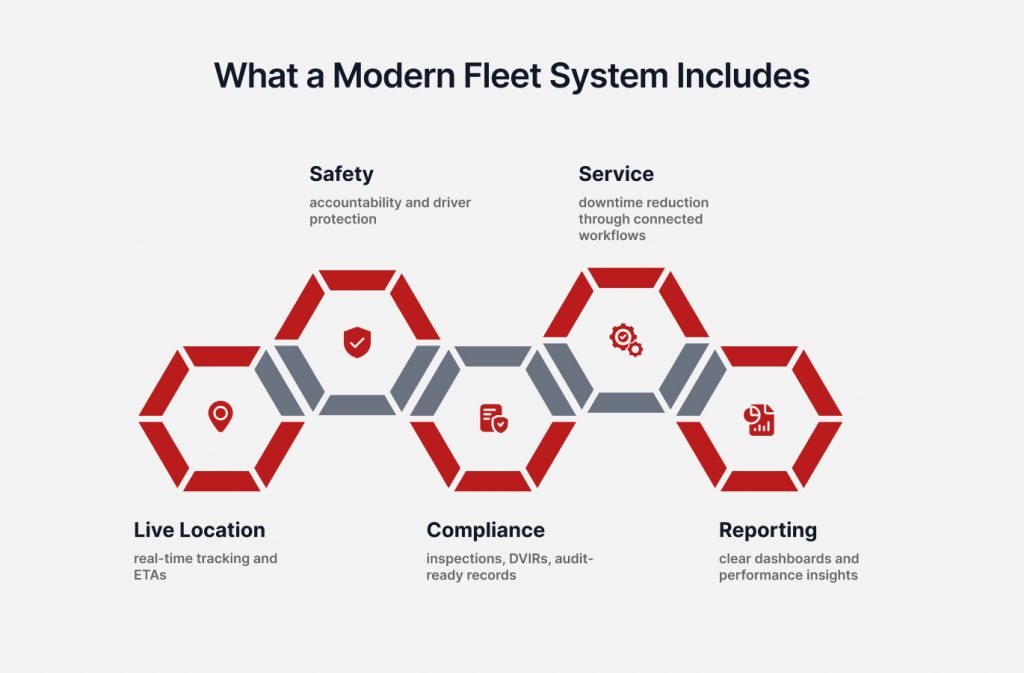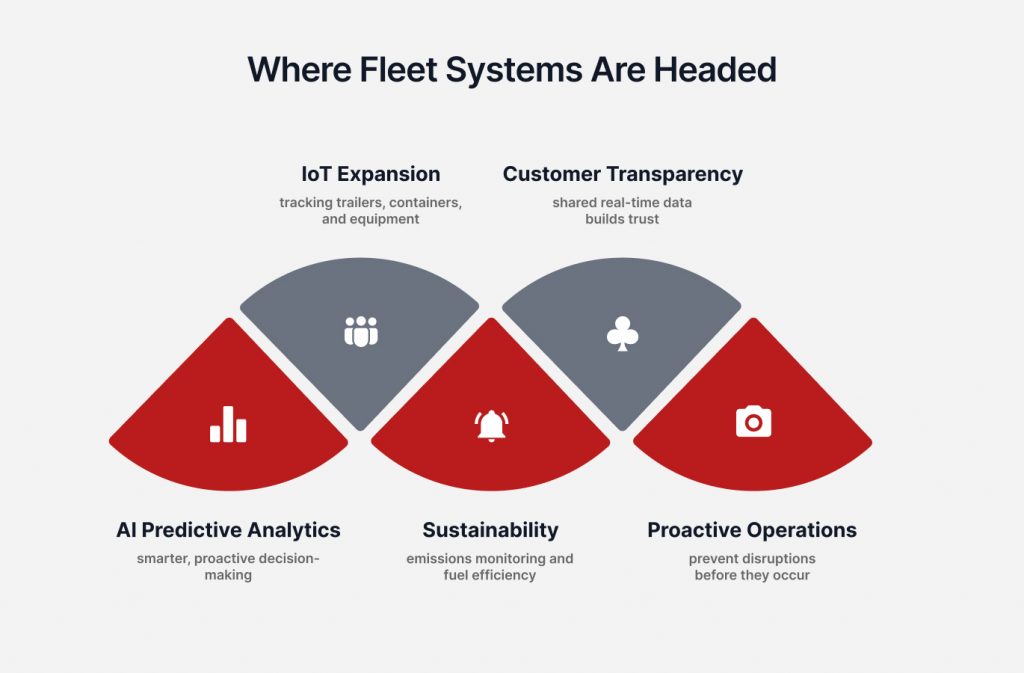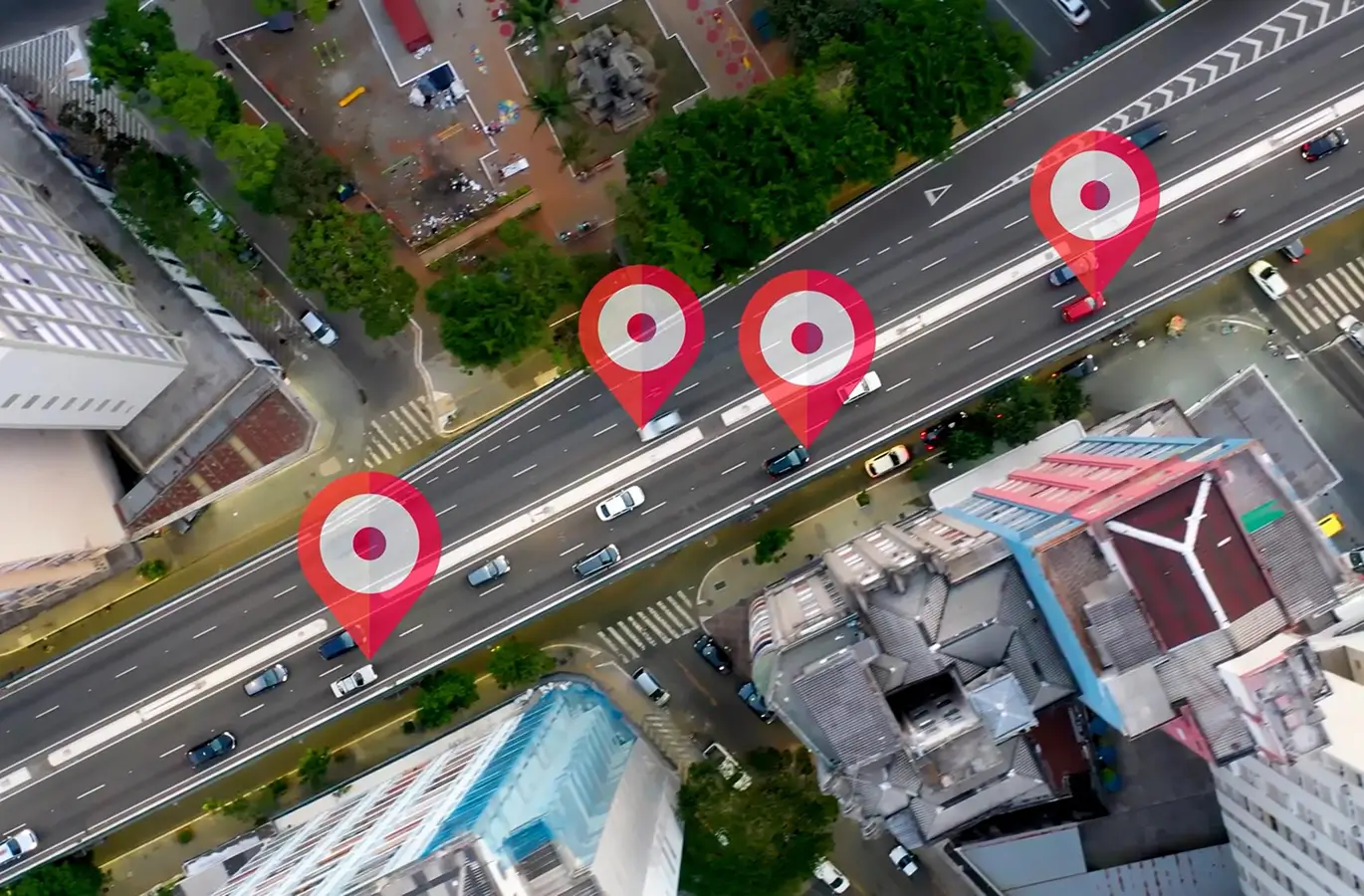Running a modern fleet is not a simple task. Vehicles cover hundreds of miles every day, drivers need constant support, compliance demands keep rising, and customers expect real-time updates on deliveries. Without the right system in place, managers are left juggling spreadsheets, making phone calls, and dealing with endless paperwork.
This is why vehicle fleet management systems have become the backbone of fleet operations in 2026. They bring together live location tracking, safety monitoring, compliance workflows, service management, and reporting into one platform. Instead of scattered tools and manual updates, managers gain a single system of record that drives efficiency and accountability across the organization.
This guide provides an overview of everything you need to know about vehicle fleet management systems. From what they are and the features they offer to the benefits, challenges, and future trends, it is designed as a complete resource. By the end, you will see why these systems are no longer optional and why REACH is defining the new standard for reliability and ROI
What is a Vehicle Fleet Management System
A vehicle fleet management system is a digital platform that helps companies organize, monitor, and optimize their fleet operations. It combines hardware devices installed in vehicles with software dashboards used by managers. Together, they provide visibility into where vehicles are, whether they are road-ready, and how efficiently they are being used.
These systems cover a wide range of functions. At the simplest level, they show live location tracking. At a more advanced level, they tie GPS data to inspections, compliance records, service events, and driver performance. This transforms raw data into actionable insights that enable fleets to reduce downtime, lower costs, and maintain compliance.
It is important to distinguish between fleet tracking devices and full fleet management systems. Devices collect and transmit location signals, but systems organize that data into workflows. For example, a device might show that a truck is on the road. In contrast, a management system shows that the truck has passed its daily inspection, has no outstanding defects, and is available for dispatch.
In 2026, fleets cannot afford to run without a management system. Regulations, customer expectations, and operational pressures are too high. The difference between companies that thrive and those that struggle often comes down to how well they use their fleet management system to turn information into results.
Core Features of Fleet Management Systems
A strong vehicle fleet management system is more than a digital map of vehicles. It is a platform that combines multiple functions to keep fleets compliant, safe, and efficient. The right system acts as the control center of operations, providing managers with the information they need to make real-time decisions.
Live Location Tracking
The foundation of any fleet system is live location tracking. Managers can see the location of vehicles at any moment, allowing them to reroute drivers, confirm deliveries, and provide accurate ETAs to customers. This visibility reduces wasted miles and improves scheduling efficiency.
Safety Monitoring and Accountability
Safety is central to fleet management. Systems monitor routes, speed, and driving patterns while also logging inspections and incidents. This data protects drivers against false claims, helps managers identify risks, and strengthens the overall safety culture of the fleet.
Compliance Tools
Fleet operations are subject to strict regulations, encompassing daily vehicle inspections and record-keeping requirements. A modern system ties compliance directly into daily workflows. Each inspection, defect, and repair is logged digitally and connected to a vehicle’s profile. When regulators request proof, fleets can provide audit-ready records instantly.
Service and Uptime Management
Downtime is one of the most expensive challenges for fleets. With a management system, inspection defects are directly linked to service events. Repairs are tracked in real-time, providing managers with clarity on when vehicles will return to operation. By shrinking downtime windows, fleets save money and protect schedules.
Reporting and Dashboards
Data is valuable only if it is actionable. Fleet management systems offer dashboards that consolidate live location, compliance readiness, service status, and driver performance in a single view. Managers no longer chase separate reports. Instead, they make faster, better decisions using integrated insights.
Core Features of a Vehicle Fleet Management System

Key Benefits for Fleets
Knowing the features of a fleet management system is important, but what matters most to managers is the results. The true test of any system is whether it saves money, reduces downtime, improves safety, and strengthens customer relationships. A well-implemented vehicle fleet management system delivers all of these benefits in ways that add measurable value.
Greater Operational Efficiency
With live location, safety logs, and service data all in one platform, managers no longer have to juggle multiple tools or chase drivers for updates. Dispatchers make faster decisions, service teams act quickly on repairs, and compliance managers stay ahead of deadlines. This reduces wasted time and improves day-to-day coordination.
Reduced Downtime
Every hour of vehicle downtime translates to lost revenue. Fleet management systems cut downtime by automatically turning inspection results into service events. Repairs are prioritized and tracked, so vehicles return to the road sooner. The ability to plan service windows instead of reacting to breakdowns helps fleets stay reliable and profitable.
Cost Savings Across the Board
Operational efficiency and reduced downtime lead directly to cost savings. Fleets cut overtime pay, avoid revenue loss from idle vehicles, and reduce fines from compliance issues. Additionally, improved routing and reduced empty miles lower fuel costs. The system quickly pays for itself by creating savings across multiple areas.
Compliance Confidence
Instead of scrambling during audits or roadside inspections, managers know their records are ready. With inspections and service logs tied directly to vehicle profiles, fleets show regulators accurate, timestamped documentation. This reduces the risk of penalties and ensures vehicles remain on the road.
Stronger Customer Trust
Customers expect transparency. They want to know not only that a delivery is on the way but also that it will arrive on time. Fleet management systems provide accurate ETAs and enable proactive updates when delays occur. This level of communication builds reliability and helps fleets win repeat business.
A Real-World Example
Imagine a service company managing 100 vehicles. Before adopting a fleet management system, it struggled with frequent breakdowns and late deliveries. After implementing the system, downtime dropped by 20 percent, compliance records became audit-ready, and customer satisfaction scores improved. These are the kinds of measurable results that show the value of modern systems.
Common Challenges with Fleet Management Systems
While fleet management systems deliver measurable value, not every implementation goes smoothly. Some fleets invest in systems only to find adoption is low, features are underused, or the platform creates new complications. Understanding the most common challenges helps managers make better choices and avoid wasted investment.
Overcomplicated Platforms
Some systems promise dozens of features, but most fleets only use a handful of them. The result is cluttered dashboards and confusing workflows that frustrate users. Instead of helping managers, the system becomes another problem to solve. Fleets need solutions that focus on practical outcomes rather than long lists of unused tools.
Device Lock-In and Lack of Flexibility
Many platforms require fleets to purchase specific hardware. This creates unnecessary costs and limits flexibility when scaling or changing needs. If the hardware underperforms, fleets are stuck with it. The best systems are hardware agnostic, integrating with multiple types of devices to give managers more control.
Poor Integration Between Modules
In some cases, compliance, service, and location tracking live in separate silos even within the same system. Managers still have to switch screens to connect the dots. This defeats the purpose of having a single platform. True integration means every inspection, defect, and service event is tied directly to the live location.
User Adoption Challenges
A fleet management system is only as strong as its adoption. If drivers find inspections difficult to log or managers struggle to interpret the dashboards, the system will not deliver the desired results. Training, intuitive design, and clear communication are essential to overcome this challenge.
How to Avoid These Pitfalls
Fleets can avoid these challenges by focusing on three priorities:
- Choose a system that emphasizes clarity and simplicity.
- Ensure it works with existing or preferred hardware.
- Look for platforms that connect location, compliance, and service in one place.
When systems are designed with these principles, adoption improves, managers stay focused on outcomes, and fleets realize full ROI.
The Future of Vehicle Fleet Management Systems
Fleet management systems are not standing still. As logistics, compliance, and customer expectations grow more complex, these platforms are evolving from operational tools into strategic assets. The next generation of systems will go beyond monitoring to predict, prevent, and optimize fleet operations in ways that deliver even more value.
AI and Predictive Analytics
Artificial intelligence will enhance the capabilities of fleet management systems. Instead of reacting to problems, systems will analyze historical data, traffic conditions, and driver behavior to predict delays, breakdown risks, or compliance issues before they occur. Managers will use these insights to act proactively and maintain smooth operations.
IoT and Asset-Level Visibility
Fleets are comprised of more than just vehicles. Trailers, containers, and high-value equipment are all part of the operation. IoT integration will expand tracking systems to cover every asset, providing real-time visibility across the entire supply chain. This broader perspective will reduce theft, improve utilization, and increase accountability.
Sustainability and Emissions Tracking
With stricter environmental regulations and growing customer demand for greener operations, future systems will play a role in sustainability. By optimizing routes, reducing idle time, and monitoring emissions, fleets can help cut costs while also reducing their carbon footprint.
Customer Transparency as the New Standard
Transparency has shifted from a competitive advantage to an expectation. In the near future, customers may have access to the same live tracking data as managers, creating a shared view of operations. This openness will build stronger trust and help fleets secure long-term contracts.
Proactive Operations
The most significant shift will be transitioning from reactive to proactive operations. Future fleet management systems will not only report what is happening but also highlight what is likely to happen next. This foresight will enable managers to make decisions more quickly, maintain uptime, and enhance customer service.
The Future of Vehicle Fleet Management

Why REACH is the Smarter Choice
With numerous fleet management systems available, fleets often face the challenge of finding one that strikes a balance between innovation and practical value. Some platforms overwhelm users with unused features, while others offer only basic tracking with little to no operational impact. REACH sets itself apart by delivering a comprehensive and user-friendly system.
Hardware Flexibility
REACH does not tie fleets to one type of device. Whether you use plug-and-play OBD units, hardwired trackers for high-value assets, or solar-powered devices for trailers, REACH consolidates all the data into a single platform. This flexibility ensures managers can choose hardware that matches their assets and budgets without compromising functionality.
Compliance-First Design
Compliance is not optional, and REACH treats it as a priority. Every inspection, DVIR, and defect log is tied directly to live vehicle data. Managers always know which vehicles are road-ready and which need service. When audits or roadside inspections occur, fleets can present digital, timestamped records instantly, reducing stress and avoiding penalties.
Service Digitization for Reduced Downtime
Downtime is one of the biggest costs in fleet management. REACH addresses this by automatically converting inspection results into service events. Repair progress is tracked in real time, and managers know exactly when vehicles will return to service. This reduces idle time, maintains schedules, and enhances asset utilization.
Clear Dashboards for Smarter Decisions
Data is valuable only when it is easy to understand. REACH provides dashboards that combine live location, compliance readiness, and service status in one view. Managers, dispatchers, and service teams see the same information, which simplifies collaboration and supports faster decision-making.
Practical ROI
While some platforms prioritize features for their own sake, REACH focuses on outcomes. Fleets gain compliance confidence, reduced downtime, stronger customer trust, and measurable savings. By delivering value where it matters most, REACH ensures the system is not just a cost but a growth driver.
Why It Matters in 2026
In an environment where fleets are under pressure to deliver more with fewer resources, REACH provides a system that meets today’s challenges while preparing for tomorrow’s innovations. It is practical, reliable, and built to help fleets succeed in both the present and the future.
A Complete Guide to Vehicle Fleet Management Systems
Vehicle fleet management systems have become essential for running modern operations. They go far beyond simple GPS tracking to deliver compliance, safety, service management, and actionable insights in one platform. Fleets that adopt these systems save money, reduce downtime, enhance customer trust, and stay ahead of regulatory requirements.
The future of these systems is even more promising. With AI, IoT integration, sustainability tracking, and greater customer transparency, they will continue to evolve into tools that not only monitor fleets but also predict and prevent problems before they occur.
For fleets seeking the right partner, REACH delivers a smarter choice. With hardware flexibility, compliance-first design, service digitization, and clear dashboards, REACH strikes the balance between today’s practical needs and tomorrow’s innovations. It turns raw data into uptime, compliance, and trust — outcomes that matter most in 2026 and beyond.
Key Takeaways
- Vehicle fleet management systems integrate live tracking, compliance, safety, service, and reporting into a single platform.
- Core features include location visibility, audit-ready compliance, safety monitoring, downtime reduction, and actionable dashboards.
- Benefits include improved efficiency, cost savings, stronger compliance confidence, and better customer trust.
- Common challenges include overcomplicated systems, device lock-in, and poor integration — all of which can be avoided with the right platform.
- The future of fleet systems includes AI, IoT, sustainability tracking, and predictive operations.
- REACH is the smarter choice, combining reliability, flexibility, and results driven by ROI.
Frequently Asked Questions (FAQs)
-
What is a vehicle fleet management system?
A vehicle fleet management system is a platform that combines GPS tracking, compliance tools, service management, and reporting into one solution. It helps fleets monitor vehicles, reduce downtime, and improve efficiency.
-
What features should a fleet system include?
Core features include live location tracking, safety monitoring, digital compliance logs, service workflows for uptime, and dashboards that provide actionable insights.
-
How do fleet management systems save money?
By reducing downtime, cutting fuel waste through smarter routing, eliminating compliance penalties, and improving scheduling efficiency, these systems quickly generate measurable cost savings.
-
What challenges do fleets face when adopting these systems?
Common challenges include overly complicated platforms, being locked into specific hardware, a lack of integration between modules, and poor user adoption. Choosing a system with clarity, flexibility, and ease of use helps overcome these issues.
-
What is the future of fleet management systems?
The future will include AI for predictive insights, IoT for asset-level visibility, sustainability tools for emissions tracking, and greater transparency for customers.
-
Why is REACH the best system for fleets in 2026?
REACH is hardware-agnostic, compliance-first, and designed to reduce downtime. It turns data into actionable workflows that protect uptime, build customer trust, and deliver ROI-driven results.



